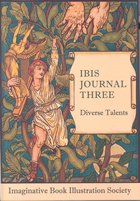
IBIS Journal 3: Diverse Talents

Journal 3 contains important and original pieces of research on three very different artists. Walter Crane was a designer, illustrator, painter, poet and teacher; Harry Furniss was a caricaturist, illustrator, writer, lecturer and showman; Helen Haywood was an author, illustrator, wood-engraver, painter of miniatures and fore-edge designs. What they seem to have in common is their energy and the diversity of their talents.
Helen Stalker, an assistant curator at the Whitworth Art Gallery in Manchester, has the task of cataloguing, archiving and interpreting the Walter Crane Collection acquired by the University of Manchester in 2002. Drawing extensively on material in that collection she has set Walter Crane’s activities as a book illustrator against the background of his personal life. Her biographical piece is complemented by a bibliography of his Toy Books which form a crucial part of his output as an illustrator and designer.
Dr Gareth Cordery has been collecting and researching the life and work of Harry Furniss for many years. He builds on the initial checklist of books and magazines illustrated by Furniss in Studies in Illustration, Issue 20 with a biographical essay and a comprehensive bibliography. Furniss was one of the few artists successfully to make the transition from the mid-Victorian period when wood-engraving was the main means of reproduction, into the era of photomechanical translation of the artist’s images to the page. He was also the first artist to make a complete set of illustrations for the works of Charles Dickens.
William Connelly’s piece on Helen Haywood brings to light the work of a little known artist of the mid-twentieth century. Whilst primarily a writer and illustrator of children’s books, she also provided artistic input to the top end of the bookbinding trade. However, the primary interest of this study is in the light it throws on the working practices of illustrators, agents and publishers in the 1950s and 1960s. Drawing on an extensive archive of correspondence between Haywood and her agents, it shows the extent to which artists had to struggle both for adequate payment for their work and for adequate recognition.
The journal has 144 pages, numerous illustrations, many in colour, handsomely bound in glossy covers.
Copies of Journal 3 may be purchased by members and non-members. Click on "How to Buy" in the menu on the left for more details.